The global inositol market is valued at USD 159.7 million in 2025 and is expected to reach USD 482.9 million by 2035, reflecting a CAGR of 11.7%. Market expansion is driven by increased demand for inositol-based supplements, especially for managing PCOS, diabetes, and neurological health.
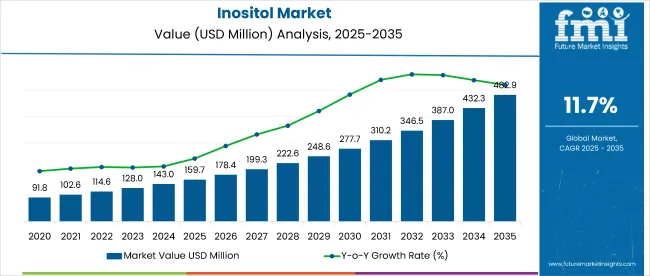
| Metric | Value |
|---|---|
| Market Size (2025) | USD 159.7 million |
| Market Size (2035) | USD 482.9 million |
| CAGR (2025 to 2035) | 11.7% |
The market is also expected to benefit from technological advancements that enhance the bioavailability and efficacy of inositol supplements.The inositol market holds approximately 6.1% of the global pharmaceuticals market and around 4.9% of the dietary supplements market, reflecting its growing importance in therapeutic and metabolic health applications.
Within the food and beverage sector, its share stands at roughly 1.8%, supported by increasing demand for functional ingredients in wellness-oriented products. In the cosmetics and personal care space, inositol accounts for about 0.9%, while in animal feed, it contributes approximately 0.6%.
Government regulations impacting the market focus on the safety, efficacy, and labeling of nutraceutical and pharmaceutical products containing inositol. Stricter compliance standards for dietary supplements and functional ingredients are encouraging manufacturers to invest in clinical research and product transparency.
Moreover, governments in Asia are actively supporting the use of plant-based compounds in therapeutic applications, which is likely to boost inositol adoption across both preventive and clinical healthcare sectors.
Japan is projected to be the fastest-growing market at a CAGR of 10.5% from 2025 to 2035, driven by its aging population and increasing demand for nutraceuticals and pharmaceutical-grade supplements.
Pharmaceutical will lead the application segment with a 33% market share in 2025, while, plant-based will lead the source segment with a 58% share.The USA and the UK markets are expected to grow at CAGRs of 9.6% and 8.8%, respectively.
The inositol market is segmented into source type, application, and region. By source type, the market comprises plant-based and synthetic inositol. Based on application, the market is categorized into dietary supplements, beverages, feed industry, pharmaceutical industry, and other applications. Regionally, the market is classified into North America, Latin America, Western Europe, Eastern Europe, Balkans & Baltic, Russia & Belarus, Central Asia, East Asia, South Asia & Pacific, Middle East & Africa.
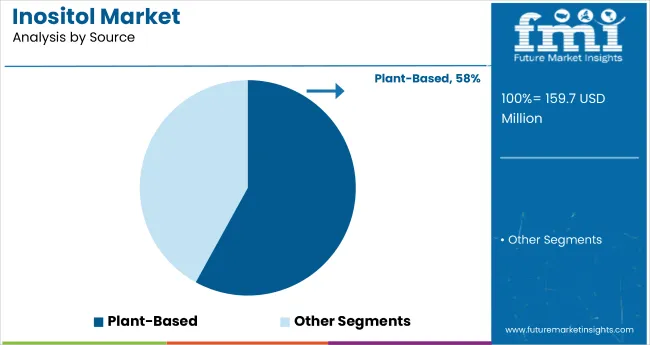
Plant-based is projected to lead the source segment, accounting for approximately 58% global market share in2025. Growth is driven by the increasing global shift toward natural, clean-label, and sustainable ingredients. Consumers are becoming more health-conscious and are seeking alternatives to synthetic compounds, particularly in the pharmaceutical, nutraceutical, and functional food industries.
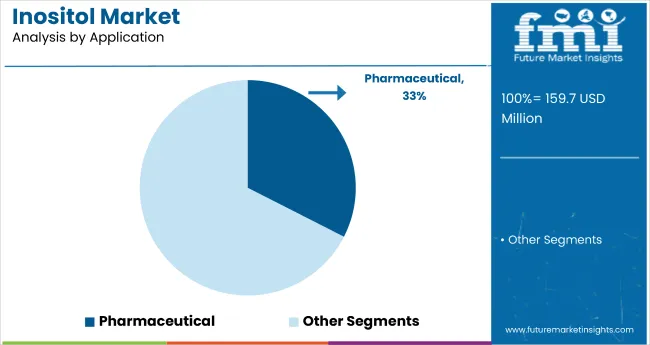
Pharmaceutical is expected to lead the application segment, accounting for 33% of the global market share in 2025. Growth is driven by the increasing utilization of inositol in the treatment of metabolic disorders such as diabetes, neurological conditions including anxiety and depression, and reproductive health issues like polycystic ovary syndrome (PCOS).
The global inositol market is growing steadily, driven by increasing demand for natural and plant-based supplements, rising awareness of metabolic and neurological health benefits, and advancements in pharmaceutical and nutraceutical formulations. Growth is further supported by expanding applications in dietary supplements, functional beverages, and treatments for conditions such as PCOS and diabetes.
Recent Trends in the Inositol Market
Challenges in the Inositol Market
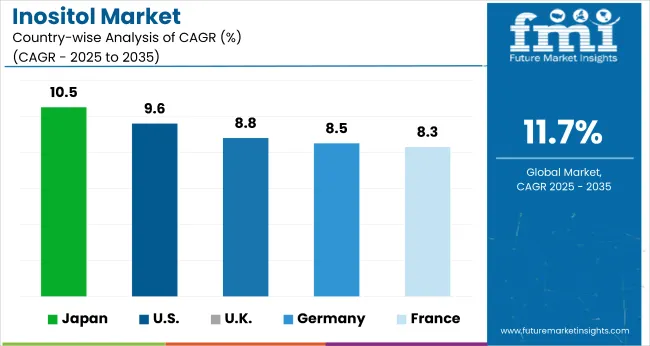
Japan leads the inositol market, driven by its aging population and a strong focus on healthcare innovation. The USA follows closely with a 9.6% CAGR, supported by advancements in dietary supplements and expanding e-commerce channels.
The UK is expected to grow at 8.8% CAGR, fueled by increasing mental health awareness and supplement adoption. Germany maintains steady growth at 8.5%, backed by stringent regulations and chronic disease management. France, with an 8.3% CAGR, benefits from rising demand for natural, plant-based, and organic health supplements.
The report covers an in-depth analysis of 40+ countries; with the five top-performing OECD nations highlighted below.
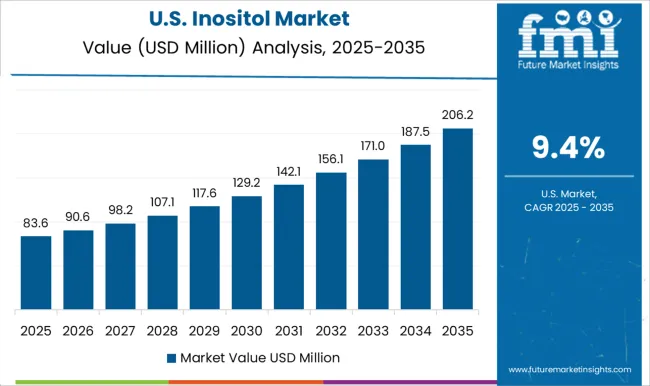
The USA inositol market is projected to grow at a CAGR of 9.6% from 2025 to 2035, driven by increasing consumer demand for dietary supplements and pharmaceutical products addressing metabolic and neurological disorders. The country benefits from advanced healthcare infrastructure and strong R&D investments, supporting innovation in inositol-based formulations.
The sales of inositol products are expanding at a CAGR of 8.8% over the forecast period. Growth is driven by rising focus on mental health and preventive care among the population is driving demand for inositol supplements. Their calming effects, metabolic support, and clean-label compatibility make them ideal for inclusion in dietary supplements, functional foods, and wellness-focused pharmaceutical products.

The demand for inositol in Germany is projected to grow at a CAGR of 8.5% from 2025 to 2035, fueled by a mature healthcare system and strong consumer interest in dietary supplements. The country has strict regulatory standards, which ensure high-quality product offerings and drive demand for clinically proven inositol formulations.
The inositol market in France is projected to grow at a CAGR of 8.3% during the forecast period, supported by growing health consciousness and increasing use of dietary supplements for metabolic and neurological health. The market is benefiting from strong government campaigns promoting natural health products and functional foods.
The inositol market in Japan is projected to grow at a CAGR of 10.5% from 2025 to 2035. Growth is driven by a and advanced healthcare system support pharmaceutical and dietary supplement applications. Their proven role in supporting cognitive function, emotional balance, and metabolic health makes inositol products ideal for inclusion in aging care, brain health supplements, and functional nutrition formulas.

The global inositol market is moderately fragmented, with several key players competing through innovation, strategic partnerships, pricing strategies, and geographic expansion. Leading companies such as DSM NV, Charles Bowman & Company, T.J. Clark & Company, Shandong Runde Biotechnology, and How tian are focusing on expanding their product portfolios and investing in R&D to develop advanced inositol formulations targeting pharmaceutical, dietary supplement, and functional food applications. These companies also leverage partnerships and acquisitions to enhance distribution networks and broaden their global footprint, particularly in high-growth markets such as Asia-Pacific and North America.
Competitive strategies among top suppliers include developing plant-based and clean-label inositol products to meet the rising consumer demand for natural ingredients. Pricing competitiveness remains crucial as synthetic alternatives often challenge market share, prompting leading firms to emphasize product quality and certifications.
Expansion into emerging markets through localized manufacturing and stronger supply chain integration also forms a core part of the growth strategy. In addition, ongoing collaborations with healthcare providers and nutraceutical companies support product innovation tailored to therapeutic needs.
| Report Attributes | Details |
|---|---|
| Current Total Market Size (2025) | USD 159.7 million |
| Projected Market Size (2035) | USD 482.9 million |
| CAGR (2025 to 2035) | 11.7% |
| Base Year for Estimation | 2025 |
| Historical Period | 2020 to 2024 |
| Projections Period | 2025 to 2035 |
| Market Analysis Parameters | Revenue in USD million/Volume in metric tons |
| By Source | Plant-Based and Synthetic |
| By Application | Dietary Supplements, Beverages, Feed Industry, Pharmaceutical Industry, and Other Applications |
| Regions Covered | North America, Latin America, Western Europe, Eastern Europe, Balkans & Baltic, Russia & Belarus, Central Asia, East Asia, South Asia & Pacific, Middle East & Africa |
| Countries Covered | United States, Canada, United Kingdom, Germany, France, China, Japan, South Korea, Brazil, Australia, +40 countries |
| Key Players | DSM NV, Charles Bowman & Company, T.J. Clark & Company, Shandong Runde Biotechnology Co., Howtian, Biological E Ltd., Ronas Chemicals, Holland & Barrett, Phoenix Herb, and Asiamerica Group, Inc. |
| Additional Attributes | Dollar sales by product type, share by functionality, regional demand growth, regulatory influence, clean-label trends, competitive benchmarking |
The global inositol market is estimated to be valued at USD 159.7 million in 2025.
The market size for the inositol market is projected to reach USD 458.2 million by 2035.
The inositol market is expected to grow at a 11.1% CAGR between 2025 and 2035.
The key product types in inositol market are plant based inositol and synthetic inositol.
In terms of application, dietary supplements segment to command 34.7% share in the inositol market in 2025.






Our Research Products

The "Full Research Suite" delivers actionable market intel, deep dives on markets or technologies, so clients act faster, cut risk, and unlock growth.

The Leaderboard benchmarks and ranks top vendors, classifying them as Established Leaders, Leading Challengers, or Disruptors & Challengers.

Locates where complements amplify value and substitutes erode it, forecasting net impact by horizon

We deliver granular, decision-grade intel: market sizing, 5-year forecasts, pricing, adoption, usage, revenue, and operational KPIs—plus competitor tracking, regulation, and value chains—across 60 countries broadly.

Spot the shifts before they hit your P&L. We track inflection points, adoption curves, pricing moves, and ecosystem plays to show where demand is heading, why it is changing, and what to do next across high-growth markets and disruptive tech

Real-time reads of user behavior. We track shifting priorities, perceptions of today’s and next-gen services, and provider experience, then pace how fast tech moves from trial to adoption, blending buyer, consumer, and channel inputs with social signals (#WhySwitch, #UX).

Partner with our analyst team to build a custom report designed around your business priorities. From analysing market trends to assessing competitors or crafting bespoke datasets, we tailor insights to your needs.
Supplier Intelligence
Discovery & Profiling
Capacity & Footprint
Performance & Risk
Compliance & Governance
Commercial Readiness
Who Supplies Whom
Scorecards & Shortlists
Playbooks & Docs
Category Intelligence
Definition & Scope
Demand & Use Cases
Cost Drivers
Market Structure
Supply Chain Map
Trade & Policy
Operating Norms
Deliverables
Buyer Intelligence
Account Basics
Spend & Scope
Procurement Model
Vendor Requirements
Terms & Policies
Entry Strategy
Pain Points & Triggers
Outputs
Pricing Analysis
Benchmarks
Trends
Should-Cost
Indexation
Landed Cost
Commercial Terms
Deliverables
Brand Analysis
Positioning & Value Prop
Share & Presence
Customer Evidence
Go-to-Market
Digital & Reputation
Compliance & Trust
KPIs & Gaps
Outputs
Full Research Suite comprises of:
Market outlook & trends analysis
Interviews & case studies
Strategic recommendations
Vendor profiles & capabilities analysis
5-year forecasts
8 regions and 60+ country-level data splits
Market segment data splits
12 months of continuous data updates
DELIVERED AS:
PDF EXCEL ONLINE

Thank you!
You will receive an email from our Business Development Manager. Please be sure to check your SPAM/JUNK folder too.
Chat With
MaRIA